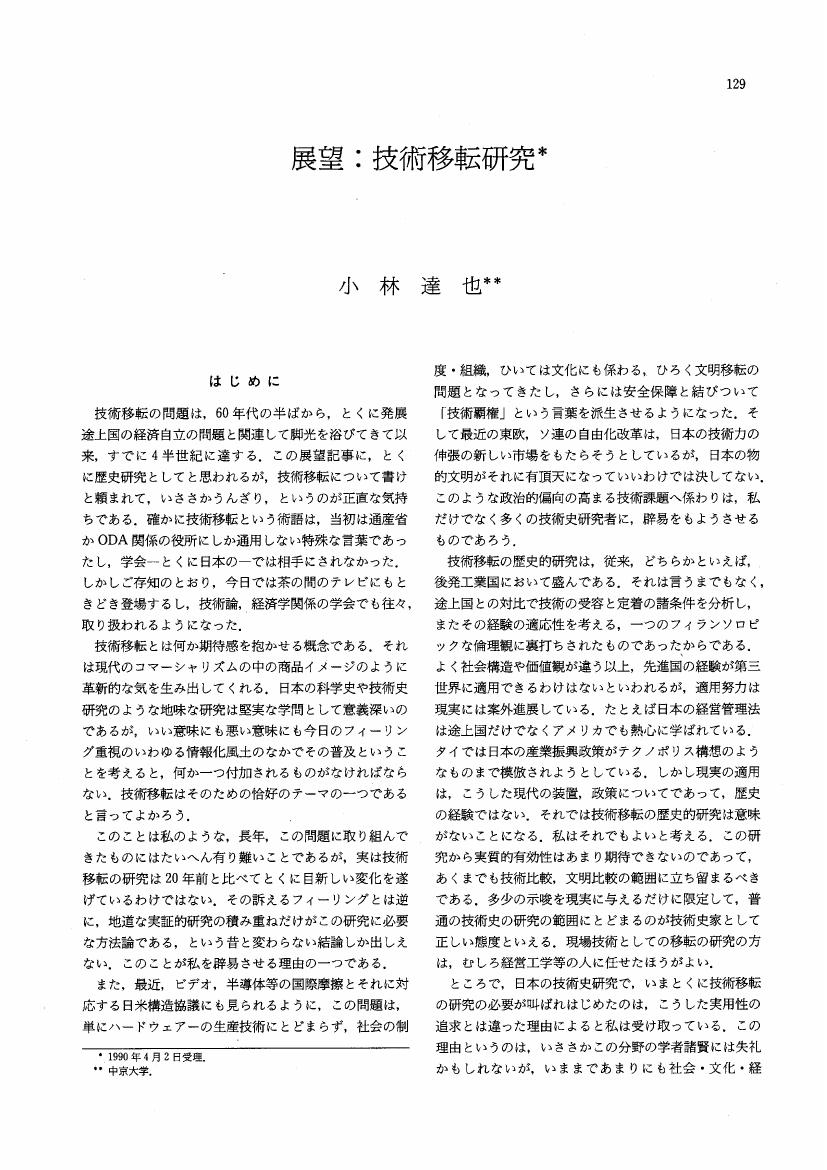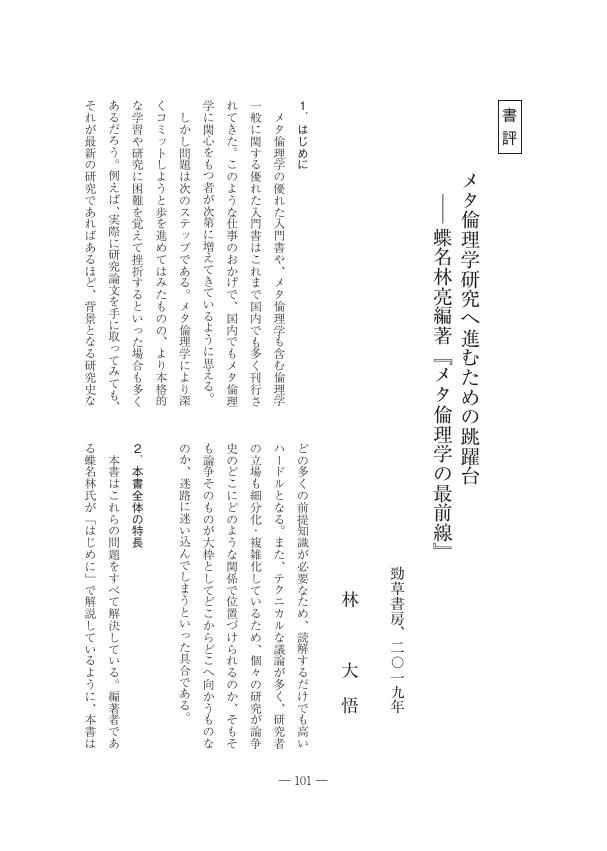1 0 0 0 OA インドにおける数列
- 著者
- 楠葉 隆徳 林 隆夫
- 出版者
- 日本科学史学会
- 雑誌
- 科学史研究 (ISSN:21887535)
- 巻号頁・発行日
- vol.32, no.185, pp.32-42, 1993 (Released:2021-03-23)
1 0 0 0 OA 本多利明の三角法と漢訳西洋暦算書との関係について
- 著者
- 小林 龍彦
- 出版者
- 日本科学史学会
- 雑誌
- 科学史研究 (ISSN:21887535)
- 巻号頁・発行日
- vol.31, no.184, pp.200-208, 1992 (Released:2021-04-03)
1 0 0 0 OA Theodor Schwannと還元主義
- 著者
- 林 真理
- 出版者
- 日本科学史学会
- 雑誌
- 科学史研究 (ISSN:21887535)
- 巻号頁・発行日
- vol.31, no.184, pp.209-214, 1992 (Released:2021-04-03)
1 0 0 0 OA 展望:技術移転研究
- 著者
- 小林 達也
- 出版者
- 日本科学史学会
- 雑誌
- 科学史研究 (ISSN:21887535)
- 巻号頁・発行日
- vol.29, no.175, pp.129-135, 1990 (Released:2021-08-30)
1 0 0 0 OA F W.Clarkeの地球化学的研究の課題について
- 著者
- 北林 雅洋
- 出版者
- 日本科学史学会
- 雑誌
- 科学史研究 (ISSN:21887535)
- 巻号頁・発行日
- vol.27, no.168, pp.215-217, 1988 (Released:2021-09-01)
1 0 0 0 OA ゼロの発見
- 著者
- 林 隆夫
- 出版者
- 日本科学史学会
- 雑誌
- 科学史研究 (ISSN:21887535)
- 巻号頁・発行日
- vol.27, no.166, pp.84-92, 1988 (Released:2021-09-06)
The decimal place-value notation with a zero symbol (called bindu or a point) is found to be used in the Yavanajataka (A.D.269/270) of Sphujidhvaja, while the recognition of the zero as a number to be an object of mathematical operations can be attested in Var hamihira's Pancasiddhantika (ca.A.D.505). In this paper I have proposed the hypothesis that a place-value notation with a zero symbol and computation on board by using that notation, both of which existed in India in the early centuries of the Christian era, were the necessary conditions for the recognition of zero as a number.
1 0 0 0 OA 関孝和の失われた著書"根元記円術十六問"について
- 著者
- 小林 龍彦 田中 薫
- 出版者
- 日本科学史学会
- 雑誌
- 科学史研究 (ISSN:21887535)
- 巻号頁・発行日
- vol.27, no.166, pp.110-115, 1988 (Released:2021-09-06)
There used to be a field called Senkyo problem or Common Part Problem in Wasan which the old Japanese mathematicians or Wasan experts earnestly studied during the Edo period. We have already explained in some journals that Takakazu Seki (1642?-1708) was able to solve the problems without using integral calculus. This time, we have found a new description about the missing note of T Seki in the introductory remarks and in the main body of KTangen Sanpo", which was wr ten by Shukei Irie in 1739 According to Irie's description, he called it uKongenki Enjutsu 16 Problems" And in the main body of the text Irie had cited, in order to solve a Senkyo Problem, that T.Seki had used an approximate formula to find the area of a segment of a circle. We were able to restore this approximate formula as follows: If we let d be the chord, c the altitude of a segment of a circle, and S the area, we have, (2d+c)cπ/10=S Through research of Irie's statement, regardless of it being true or not, we obtained some new facts about T. Seki as follows: Firstly, it is obvious that Seki studied "Sanpo Kongenki" written by Seiko Sato in 1669, from which he learned an approximate formula like the one mentioned above. We believe that this matter may create a new point of view on the study of T. Seki. Secondly, T. Seki must have made a note called "Kongenki Enjutsu 16 Problems" immediately after "Kokon Sanpoki" by Kazuyuki Sawaguchi was published. This is because K. Sawaguchi did not solve 16 out of 150 problems in "Sanpo Kongenki", which Sato poured out as new questions for Wasan experts of that time. Thus, we are able to place the missing note in an early time of his work. Thirdly, it is certain that Seki's successors have passed on this missing note for mathematical education and it existed until around the end of the first half of the 18th century.
1 0 0 0 OA 村井中漸び「算学系統・弧背密術」について -特に関孝和に関する記述を中心に
- 著者
- 小林 龍彦 田中 薫
- 出版者
- 日本科学史学会
- 雑誌
- 科学史研究 (ISSN:21887535)
- 巻号頁・発行日
- vol.25, no.159, pp.137-141, 1986 (Released:2021-04-03)
1 0 0 0 OA 関孝和の円錐曲線の研究について-特に「測量全義」と比較して-
- 著者
- 小林 龍彦 田中 薫
- 出版者
- 日本科学史学会
- 雑誌
- 科学史研究 (ISSN:21887535)
- 巻号頁・発行日
- vol.24, no.155, pp.149-154, 1985 (Released:2021-04-07)
1 0 0 0 OA 江戸時代初期のπの計算について
- 著者
- 小林 龍彦 田中 薫
- 出版者
- 日本科学史学会
- 雑誌
- 科学史研究 (ISSN:21887535)
- 巻号頁・発行日
- vol.22, no.148, pp.206, 1983 (Released:2021-09-24)
In the Sanso of 1663, Shigekiyo Muramatu (1608〜1695) made calculations of the circumferences of a regular square, a regular octagon, a regular sixteen-sided polygon, …… inscribed in the circle with the diameter 1,and ended in the circumferences of regular 2¹⁵ -sided polygon. And he got π=3.141592648777698869248 from this conclusion. Similarly Takakazu Seki (1640?〜1708) wrote the Katsuyȏ-Sanpȏ in 1712, in which he showed his measurement of the circle. From the perimeter of an inscribed 2¹⁷-sided polygon, he let the circumferences of a regular 2¹⁵ sided polygon be a, that of a regular 2¹⁶-sided polygon be b, and that of a regular 2¹⁷-sided polygon be c, and he made calculations as follows: b+(b-a)(c-b)/(b-a)-(c-b)=3.14159265359 "extremely weak". Shu-Li-Jing-Yun was introduced into Japan in about 1723. In this book Ludolf (1540〜1610) also showed his measurement of the circle, and he got π=3.141592653589793238431541553377501511680 from the perimeter of an inscribed 2³⁵-sided polygon. In this paper we made a comparative study with the process of their measurements, which is an oblique side of rectangular triangles produced in each process.
1 0 0 0 OA 和算における穿去題について ―関孝和の穿去題の研究とその継承―
- 著者
- 小林 龍彦 田中 薫
- 出版者
- 日本科学史学会
- 雑誌
- 科学史研究 (ISSN:21887535)
- 巻号頁・発行日
- vol.22, no.147, pp.154-159, 1983 (Released:2021-09-24)
We studied Problems of the Pierced Object in the Old Japanese Mathematics and we took statistics on these problems in mathematical Tablets. The investigation revealed the fact that many problems were studied during the Bunsei (1818〜1830), especially in and around Edo. And after that period they spread in the country. The main objects of this paper are to give the analysis of the above-mentioned investigation, especially to make the history of mathematical solution clear in these problems.
1 0 0 0 OA 和算にあらわれた周転円(Epicycle)について
- 著者
- 小林 龍彦 田中 薫
- 出版者
- 日本科学史学会
- 雑誌
- 科学史研究 (ISSN:21887535)
- 巻号頁・発行日
- vol.22, no.145, pp.47-50, 1983 (Released:2021-10-06)
Toshisada ENDO, states that the first discovery of cycloid during the Bunsei period (1818〜1828) is attributed to Nei Wada (1787~1840). On the other hand, Yoshio MIKAMI pointed out that the same subject had already been studied by Tadao SHIZUKI (1760〜1806) in his Rekishō Shinsho (vol.1,1798; Vol.2, 1800; Vol.3, 1802). But these works seems to be insufficient, so we have discussed the same subject from astronomical points of view.
1 0 0 0 高耐圧絶縁型コンバータの絶縁トランス構造の検討
- 著者
- 小林 皓祐 平木 英治
- 出版者
- パワーエレクトロニクス学会
- 雑誌
- パワーエレクトロニクス学会誌 (ISSN:13488538)
- 巻号頁・発行日
- vol.46, pp.115, 2020 (Released:2021-07-29)
- 参考文献数
- 1
- 著者
- 岡林 洋
- 出版者
- 美学会
- 雑誌
- 美学 (ISSN:05200962)
- 巻号頁・発行日
- vol.70, no.1, pp.108-111, 2019 (Released:2021-05-08)
1 0 0 0 OA 美学と癒し G・ F・マイアー(一七一八─七七)の 美学的情動論をめぐって
- 著者
- 小林 直子
- 出版者
- 美学会
- 雑誌
- 美学 (ISSN:05200962)
- 巻号頁・発行日
- vol.70, no.1, pp.123, 2019 (Released:2021-05-08)
1 0 0 0 OA 5.食品
- 著者
- 林 徹
- 出版者
- 公益社団法人 日本アイソトープ協会
- 雑誌
- RADIOISOTOPES (ISSN:00338303)
- 巻号頁・発行日
- vol.47, no.4, pp.363-373, 1998-04-15 (Released:2010-07-21)
- 参考文献数
- 8
1 0 0 0 OA 地下外壁外防水先やり工法の不具合事例調査
- 著者
- 岡本 肇 田中 享二 小林 茂 山中 勇人 内海 孝康
- 出版者
- 一般社団法人 日本建築学会
- 雑誌
- 日本建築学会技術報告集 (ISSN:13419463)
- 巻号頁・発行日
- vol.16, no.33, pp.435-440, 2010-06-20 (Released:2010-06-18)
- 参考文献数
- 2
- 被引用文献数
- 1 1
This paper is described about the failures of waterproofing membranes for underground structures applied on earth retaining walls prior to wall concreting. In this waterproofing system the quality of waterproofing work may become worse and failures increase because waterproofing membrane is applied to irregular surface of the earth retaining wall, waterproofing work is complicated with demolition work of earth retaining wall and concreting work. So it must be recognized the note of this system and needs to make standard of this system. Before standardizing, we researched the failures of this method and classified.
1 0 0 0 OA メタ倫理学研究へ進むための跳躍台 蝶名林亮編著『メタ倫理学の最前線』
- 著者
- 林 大悟
- 出版者
- 西日本哲学会
- 雑誌
- 西日本哲学年報 (ISSN:09197982)
- 巻号頁・発行日
- vol.28, pp.101, 2020 (Released:2021-05-06)
1 0 0 0 OA 現象学とギブソン 「表象」概念の位置づけtについて
- 著者
- 小林 睦
- 出版者
- 東北哲学会
- 雑誌
- 東北哲学会年報 (ISSN:09139354)
- 巻号頁・発行日
- vol.32, pp.63-81, 2016 (Released:2022-08-04)













